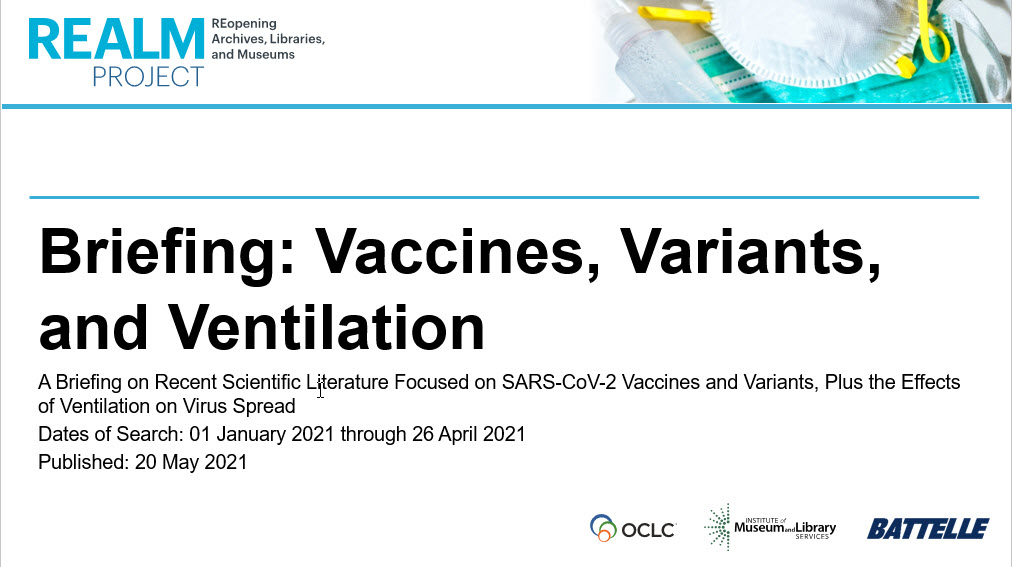REALM Project
REopening
Archives, Libraries,
and Museums
Research
Research > Briefing - Vaccines, variants and ventilation
Research briefing: Vaccines, variants and ventilation
This briefing, prepared by researchers at Battelle, is intended to provide timely information about SARS-CoV-2 vaccines and variants to libraries, archives, and museums (LAMs), and their stakeholders. This is a review of scientific literature published through 26 July 2021, and should be used in conjunction with other timely resources to ensure decision-making in LAMs reflects the latest scientific understanding. Continual re-evaluation of SARS-CoV-2 policies is highly recommended as new scientific discoveries are published.
Research questions
- What implications does SARS-CoV-2 vaccination in the US have for public health interventions and policies, especially related to indoor environments?
- What differences have been found for SARS-CoV-2 variants (compared to the original strain) in the US in terms of spread, transmissibility, surface attenuation, and effectiveness of public health interventions?
- What effects do ventilation and ventilation-based interventions (e.g., heating, ventilation, and air conditioning systems (HVAC)) have on the spread of SARS-CoV-2 in indoor environments?
HIGHLIGHTS
- Ventilation: A study focusing on mitigation of classroom transmission found that ventilation changes were effective at reducing mean transmission risk by 25 percent, while increasing social distancing from 1.5 to 3 meters decreased transmission risk by 65 percent (slide 31).
- Ventilation: Experts recommended that exhaust fans in restrooms should operate at all times. They also noted that windows in restrooms should not be opened, as exhausted air may reenter (slide 38.)
- Vaccines: Equitable access to COVID-19 vaccines among racial and ethnic minorities is a key concern, as Hispanics and Blacks are less likely to have had at least one vaccine dose compared to Whites and Asians. Researchers have identified that COVID-19 continues to disproportionally impact the Black community, further worsening health disparities already present due to racism and its effects on social and economic factors. Efforts also need to be made to improve access among persons in low socioeconomic areas and persons with disabilities (slide 16).
Notes for the reader
As you read this briefing, keep in mind a few key points:
- The research and information captured in the findings include both peer-reviewed and non-peer-reviewed studies. In the interest of publishing emerging research related to the COVID-19 pandemic as quickly as possible, publication has been expedited rather than waiting for time-intensive peer review.
- The review includes findings for industries, such as health care, that operate under considerably different constraints and risk factors than do libraries, archives, and museums (LAMs). However, it was important to consider a broad range of available research to determine what may be applicable to LAM operations and identify what research gaps exist. The research captured in the review does not represent recommendations or guidance for LAMs.
- Additional literature reviews and research briefings are available from REALM.
- A helpful resource for those interested in tracking the "known unknowns" about this virus is the DHS Master Question List for COVID-19 (caused by SARS-CoV-2)

